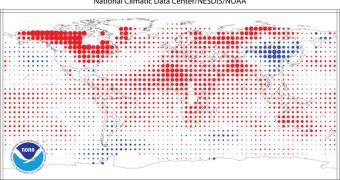The US National Oceanic and Atmospheric Administration (NOAA) announces that last month was the warmest on record. The agency also shows that the period of time spanning from January to April was also the warmest ever recorded. The new report is based on numerous datasets, which combine global land and ocean surface temperatures in a single view of how our planet is doing. The average temperature of the oceans this April was the highest ever recorded, while the land surface was only the third warmest on record. The research is part of the latest monthly analysis released by the NOAA National Climatic Data Center (NCDC).
The data the Center makes available to government, business and community leaders are among the most respected in the community. The record files the NCDC keeps on global weather stretch back to 1880, and so experts here are uniquely qualified to make long-term analyses and comparisons between various time frames. “The combined April global land and ocean average surface temperature was the warmest on record at 58.1°F (14.5°C), which is 1.37°F (0.76°C) above the 20th century average of 56.7°F (13.7°C),” NOAA officials write in a press release.
Scientists explain that the warmth observed in the tropical belt, as well as the one registered in the overall ocean, were most likely caused by the El Niño Southern Oscillation (ENSO). The atmospheric phenomenon weakened considerably in April, and this translated in a drop in the number of temperature anomalies usually recorded above the Pacific Ocean. The global ocean surface, including the equatorial portion of the Atlantic, was found to be 1.03°F (0.57°C) above the 20th century average of 60.9°F (16.0°C). Though these differences may seem very small in absolute terms, researchers warn that a temperature increase of just 2 degrees Celsius could have severe negative repercussions, including flooding, sea level rise, disturbed atmospheric patterns and so on.
According to NOAA, most high temperature anomalies were recorded in the eastern United States, northern Russia, Alaska, Canada, South Asia, Australia and northern Africa. On the other hand, lower-than-average temperatures were found in Argentina, China, eastern Russia, Mongolia, and the western coast of the United States. The NOAA Climate Prediction Center reports that the El Niño phenomenon will most likely continue through June, which means that we should expect to see more anomalous temperature readings around the globe.

 14 DAY TRIAL //
14 DAY TRIAL //